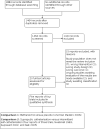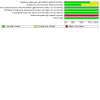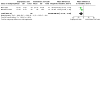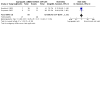Postoperative interventions for preventing bladder dysfunction after radical hysterectomy in women with early-stage cervical cancer
- PMID: 33491176
- PMCID: PMC8092645
- DOI: 10.1002/14651858.CD012863.pub2
Postoperative interventions for preventing bladder dysfunction after radical hysterectomy in women with early-stage cervical cancer
Abstract
Background: Bladder dysfunction is a common complication following radical hysterectomy, caused by the damage to pelvic autonomic nerves that innervate the muscles of the bladder, urethral sphincter, and pelvic floor fasciae. Bladder dysfunction increases the rates of urinary tract infection, hospital visits or admission, and patient dissatisfaction. In addition, bladder dysfunction can also negatively impact patient quality of life (QoL). Several postoperative interventions have been proposed to prevent bladder dysfunction following radical hysterectomy. To our knowledge, there has been no systematic review evaluating the effectiveness and safety of these interventions for preventing bladder dysfunction following radical hysterectomy in women with cervical cancer.
Objectives: To evaluate the effectiveness and safety of postoperative interventions for preventing bladder dysfunction following radical hysterectomy in women with early-stage cervical cancer (stage IA2 to IIA2).
Search methods: We searched the Cochrane Central Register of Controlled Trials (CENTRAL; 2020, Issue 4) in the Cochrane Library, MEDLINE via Ovid (1946 to April week 2, 2020), and Embase via Ovid (1980 to 2020, week 16). We also checked registers of clinical trials, grey literature, conference reports, and citation lists of included studies.
Selection criteria: We included randomised controlled trials (RCTs) evaluating the effectiveness and safety of any type of postoperative interventions for preventing bladder dysfunction following a radical hysterectomy in women with stage IA2 to IIA2 cervical cancer.
Data collection and analysis: Two review authors independently selected potentially relevant RCTs, extracted data, assessed risk of bias, compared results, and made judgments on the quality and certainty of the evidence. We resolved any disagreements through discussion or consultation with a third review author. Outcomes of interest consisted of spontaneous voiding recovery one week after the operation, quality of life (QoL), adverse events, post-void residual urine volume one month after the operation, urinary tract infection over the one month following the operation, and subjective urinary symptoms.
Main results: We identified 1464 records as a result of the search (excluding duplicates). Of the 20 records that potentially met the review criteria, we included five reports of four studies. Most of the studies had unclear risks of selection and reporting biases. Of the four studies, one compared bethanechol versus placebo and three studies compared suprapubic catheterisation with intermittent self-catheterisation. We identified two ongoing studies. Bethanechol versus placebo The study reported no information on the rate of spontaneous voiding recovery at one week following the operation, QoL, adverse events, urinary tract infection in the first month after surgery, and subjective urinary symptoms for this comparison. The volume of post-void residual urine, assessed at one month after surgery, among women receiving bethanechol was lower than those in the placebo group (mean difference (MD) -37.4 mL, 95% confidence interval (CI) -60.35 to -14.45; one study, 39 participants; very-low certainty evidence). Suprapubic catheterisation versus intermittent self-catheterisation The studies reported no information on the rate of spontaneous voiding recovery at one week and post-void residual urine volume at one month following the operation for this comparison. There was no difference in risks of acute complication (risk ratio (RR) 0.77, 95% CI 0.24 to 2.49; one study, 71 participants; very low certainty evidence) and urinary tract infections during the first month after surgery (RR 0.77, 95% CI 0.53 to 1.13; two studies, 95 participants; very- low certainty evidence) between participants who underwent suprapubic catheterisation and those who underwent intermittent self-catheterisation. Available data were insufficient to calculate the relative measures of the effect of interventions on QoL and subjective urinary symptoms.
Authors' conclusions: None of the included studies reported rate of spontaneous voiding recovery one week after surgery, time to a post-void residual volume of urine of 50 mL or less, or post-void residual urine volume at 6 and 12 months after surgery, all of which are important outcomes for assessing postoperative bladder dysfunction. Limited evidence suggested that bethanechol may minimise the risk of bladder dysfunction after radical hysterectomy by lowering post-void residual urine volume. The certainty of this evidence, however, was very low. The effectiveness of different types of postoperative urinary catheterisation (suprapubic and intermittent self-catheterisation) remain unproven.
Copyright © 2021 The Cochrane Collaboration. Published by John Wiley & Sons, Ltd.
Conflict of interest statement
Apiwat Aue‐aungkul: none known Chumnan Kietpeerakool: none known Siwanon Rattanakanokchai: none known Khadra Galaal: none known Teerayut Temtanakitpaisan: none known Chetta Ngamjarus: none known Pisake Lumbiganon: none known
Figures














Update of
- doi: 10.1002/14651858.CD012863
Similar articles
-
Evaluating the effectiveness of early urethral catheter removal combined with intermittent catheterization for promoting early recovery of bladder function after laparoscopic radical hysterectomy: a study protocol for a randomized controlled trial.Trials. 2024 Jun 28;25(1):422. doi: 10.1186/s13063-024-08266-8. Trials. 2024. PMID: 38943177 Free PMC article.
-
Nerve-sparing radical hysterectomy compared to standard radical hysterectomy for women with early stage cervical cancer (stage Ia2 to IIa).Cochrane Database Syst Rev. 2019 Feb 12;2(2):CD012828. doi: 10.1002/14651858.CD012828.pub2. Cochrane Database Syst Rev. 2019. PMID: 30746689 Free PMC article. Review.
-
Extended-field radiotherapy for locally advanced cervical cancer.Cochrane Database Syst Rev. 2018 Oct 26;10(10):CD012301. doi: 10.1002/14651858.CD012301.pub2. Cochrane Database Syst Rev. 2018. PMID: 30362204 Free PMC article.
-
Strategies for the removal of short-term indwelling urethral catheters in adults.Cochrane Database Syst Rev. 2021 Jun 29;6(6):CD004011. doi: 10.1002/14651858.CD004011.pub4. Cochrane Database Syst Rev. 2021. PMID: 34184246 Free PMC article.
-
Pessaries (mechanical devices) for managing pelvic organ prolapse in women.Cochrane Database Syst Rev. 2020 Nov 18;11(11):CD004010. doi: 10.1002/14651858.CD004010.pub4. Cochrane Database Syst Rev. 2020. PMID: 33207004 Free PMC article.
Cited by
-
Timing of Trial of Void After Radical Hysterectomy: Long-Term Urinary Outcomes at Two Academic Tertiary Care Institutions.Int Urogynecol J. 2024 Oct;35(10):1961-1968. doi: 10.1007/s00192-024-05888-z. Epub 2024 Aug 14. Int Urogynecol J. 2024. PMID: 39141112
-
Comparison of surgical and oncological outcomes between different surgical approaches for overweight or obese cervical cancer patients.J Robot Surg. 2024 Mar 4;18(1):107. doi: 10.1007/s11701-024-01863-4. J Robot Surg. 2024. PMID: 38436785 Free PMC article.
-
Summary of evidence on prevention and management of bladder dysfunction in patients after radical hysterectomy.Nurs Open. 2024 Jul;11(7):e2240. doi: 10.1002/nop2.2240. Nurs Open. 2024. PMID: 38989536 Free PMC article. Review.
-
Simple hysterectomy SHAPE-ing up to be the treatment of choice for early cervical cancer under 2 cm.J Gynecol Oncol. 2024 Mar;35(2):e49. doi: 10.3802/jgo.2024.35.e49. Epub 2024 Jan 12. J Gynecol Oncol. 2024. PMID: 38425139 Free PMC article. No abstract available.
-
Evaluating the effectiveness of early urethral catheter removal combined with intermittent catheterization for promoting early recovery of bladder function after laparoscopic radical hysterectomy: a study protocol for a randomized controlled trial.Trials. 2024 Jun 28;25(1):422. doi: 10.1186/s13063-024-08266-8. Trials. 2024. PMID: 38943177 Free PMC article.
References
References to studies included in this review
Madeiro 2006 {published data only}
-
- Madeiro AP, Rufino AC, Sartori MG, Baracat EC, DeLima GR, Girao MJ. The effects of bethanechol and cisapride on urodynamic parameters in patients undergoing radical hysterectomy for cervical cancer. A randomized, double-blind, placebo-controlled study. International Urogynecology Journal and Pelvic Floor Dysfunction 2006;17(3):248-52. - PubMed
Naik 2005 {published data only}
-
- Naik R, Maughan K, Nordin A, Lopes A, Godfrey KA, Hatem MH. A prospective randomised controlled trial of intermittent self-catheterisation vs. supra-pubic catheterisation for post-operative bladder care following radical hysterectomy. Gynecologic Oncology 2005;99:437-42. - PubMed
-
- Roberts K, Naik R. Catheterization options following radical surgery for cervical cancer. British Journal of Nursing 2006;15(19):1038-44. - PubMed
Nwabineli 1993 {published data only}
-
- Nwabineli NJ, Walsh DJ, Davis JA. Urinary drainage following radical hysterectomy for cervical carcinoma - a pilot comparison of urethral and suprapubic routes. International Journal of Gynecological Cancer 1993;3(4):208-10. - PubMed
Suprasert 2002 {published data only}
-
- Suprasert P, Srisomboon J, Phongnarisorn C. A prospective randomized study comparing voiding time between suprapubic catheterization and intermittent self-catheterization following radical hysterectomy and pelvic lymphadenectomy for cervical cancer. Thai Journal of Obstetrics and Gynaecology 2002;14(1):73-9. - PubMed
References to studies excluded from this review
Chen 2012 {published data only}
-
- Chen C, Li W, Li F, Liu P, Zhou J, Lu L, et al. Classical and nerve-sparing radical hysterectomy: an evaluation of the nerve trauma in cardinal ligament. Gynecologic Oncology 2012;125:245-51. - PubMed
Chen 2014 {published data only}
-
- Chen L, Zhang WN, Zhang SM, Yang ZH, Zhang P. Effect of laparoscopic nerve-sparing radical hysterectomy on bladder function, intestinal function recovery and quality of sexual life in patients with cervical carcinoma. Asian Pacific Journal Cancer Prevention 2014;15(24):10971-5. - PubMed
Dy Echo 2011 {published data only}
-
- Dy Echo AV and Luna JT. The role of solifenacin succinate in the management of bladder dysfunction in post-radical hysterectomy patients: an interim report. International Journal of Gynecological Cancer 2011;21(12):321.
Dy Echo 2012 {published data only}
-
- Dy Echo AV, Luna JT, Quirapas GQ. The role of solifenacin succinate in the management of bladder dysfunction in radical hysterectomy patients. Philippine Journal of Obstetrics & Gynecology 2012;30(1):1-10.
Fanfani 2015 {published data only}
-
- Fanfani F, Costantini B, Mascilini F, Vizzielli G, Gallotta V, Vigliotta M, et al. Early postoperative bladder training in patients submitted to radical hysterectomy: is it still necessary? A randomized trial. Archives of Gynecology and Obstetrics 2015;291:883-8. - PubMed
-
- Santaguida S, Tortorella L, Vigliotta M, Margariti PA, Moruzzi MC, Scambia G, et al. Bladder training after nerve-sparing radical hysterectomy in cervical cancer patients: Is it necessary? In: International Journal of Gynecology & Obstetrics. Vol. 119. 2012:472.
Gong 2016 {published data only}
-
- Gong Y, Zhao L, Wang L, Wang F. The effect of clamping the indwelling urinary catheter before removal in cervical cancer patients after radical hysterectomy. Journal of Clinical Nursing 2016;26(7-8):1131-6. - PubMed
Kuo 2005 {published data only}
-
- Kuo HC. Effectiveness of urethral injection of botulinum a toxin in the treatment of voiding dysfunction after radical hysterectomy. Urologia Internationalis 2005;75(3):247-51. - PubMed
Li 2019 {published data only}
Manchana 2011 {published data only}
-
- Manchana T, Prasartsakulchai C. Bethanechol chloride for the prevention of bladder dysfunction after radical hysterectomy in gynecologic cancer patients: a randomized controlled trial study. International Journal of Gynecological Cancer 2011;21(4):730-6. - PubMed
Pengsaa 1992 {published data only}
-
- Pengsaa P, Pothinam S, Udomthavornsok B. Urinary drainage following radical hysterectomy. Thai Journal of Obstetrics and Gynaecology 1992;4(2):125-8.
Wang 2015 {published data only}
-
- Wang HF, Wang DB, Chen YH, Zhou MY. Relief of urinary retention after radical hysterectomy for cervical cancer patients by acupressure: a randomized controlled trial. Chinese Journal of Integrated Traditional and Western Medicine 2015;35(4):425-8. - PubMed
Wells 2008 {published data only}
-
- Wells TH, Steed H, Capstick V, Schepanksy A, Hiltz M, Faught W. Suprapubic or urethral catheter: what is the optimal method of bladder drainage after radical hysterectomy? Journal of Obstetrics & Gynaecology Canada: JOGC 2008;30(11):1034-8. - PubMed
References to studies awaiting assessment
Cheng 2017 {published data only}
-
- Cheng W, Wang S, Sun X, Wang, J. The effect of TENS on postoperative urinary function in early cervical cancer (42nd Annual Meeting – Vancouver, Canada, June 20 – 24, 2017). In: International Urogynecology Journal. Vol. 28. Springer London, 2017:Supplement 1.
References to ongoing studies
Boonthongtho 2016 {published data only}
-
- Effectiveness of Bethanechol Chloride and Early Bladder Training for Prevention of Bladder Dysfunction After Radical Hysterectomy in Cervical Cancer Stage IB - IIA. Ongoing study. October 2016. Contact author for more information.
Sun 2017 {published data only}
Additional references
Abrams 2003
-
- Abrams P, Cardozo L, Fall M, Griffiths D, Rosier P, Ulmsten U, et al. The standardisation of terminology in lower urinary tract function: report from the standardisation sub-committee of the International Continence Society. Urology 2003;61(1):37-49. - PubMed
Aue‐aungkul 2017
-
- Aue-aungkul A, Kietpeerakool C, Galaal K, Temtanakitpaisan T, Ngamjarus C, Lumbiganon P. Postoperative interventions for preventing bladder dysfunction after radical hysterectomy in women with early-stage cervical cancer. Cochrane Database of Systematic Reviews 2017, Issue 11. Art. No: CD012863. [DOI: 10.1002/14651858.CD012863] - DOI - PMC - PubMed
Barry 1992
-
- Barry MJ, Fowler FJ Jr, O’Leary MP, Bruskewitz RC, Holtgrewe HL, Mebust WK, et al. The American Urological Association symptom index for benign prostatic hyperplasia. The Measurement Committee of the American Urological Association. Journal of Urology 1992;148(5):1549–57. - PubMed
Bhatla 2019
-
- Bhatla N, Berek JS, Cuello Fredes M, Denny LA, Grenman S, Karunaratne K, et al. Revised FIGO staging for carcinoma of the cervix uteri. International Journal of Gynecology & Obstetrics 2019;145(1):129-35. - PubMed
Bray 2018
-
- Bray F, Ferlay J, Soerjomataram I, Siegel RL, Torre LA, Jemal A. Global cancer statistics 2018: GLOBOCAN estimates of incidence and mortality worldwide for 36 cancers in 185 countries. CA: A Cancer Journal for Clinicians 2018;68(6):394-424. - PubMed
Chen 2002
-
- Chen GD, Lin LY, Wang PH, Lee HS. Urinary tract dysfunction after radical hysterectomy for cervical cancer. Gynecologic Oncology 2002;85(2):292-7. - PubMed
Chen 2020
-
- Chen X, Zhao N, Ye P, Chen J, Nan X, Zhao H, et al. Comparison of laparoscopic and open radical hysterectomy in cervical cancer patients with tumor size ≤ 2 cm. International Journal of Gynecologic Cancer 2020;30(5). - PubMed
Cho 2009
-
- Cho SY, Yi JS, Oh SJ. The clinical significance of poor bladder compliance. Neurourology and Urodynamics: Official Journal of the International Continence Society 2009;28(8):1010-4. - PubMed
CTCAE 2010
-
- US Department of Health and Human Services (National Institutes of Health, National Cancer Institute). Common Terminology Criteria for Adverse Events (CTCAE) Version 4.03. evs.nci.nih.gov/ftp1/CTCAE/CTCAE_4.03_2010-06-14_QuickReference_5x7.pdf (accessed 16 October 2017).
Cull 1993
Cusimano 2019
-
- Cusimano MC, Baxter NN, Gien LT, Moineddin R, Liu N, Dossa F, et al. Impact of surgical approach on oncologic outcomes in women undergoing radical hysterectomy for cervical cancer. American Journal of Obstetrics and Gynecology 2019;221(6):619.e1-619.e24. - PubMed
Deeks 2001
-
- Deeks J, Altman D, Bradburn M. Statistical methods for examining heterogeneity and combining results from several studies in meta-analysis. 2nd edition. London (UK): BMJ Publication Group, 2001.
DeSimonian 1986
-
- DerSimonian R, Laird N. Meta-analysis in clinical trials. Controlled Clinical Trials 1986;7(3):177-88. - PubMed
Endnote [Computer program]
-
- Endnote. Version X7. New York (NY): Thomas Reuters, 2015.
Ferlay 2015
-
- Ferlay J, Soerjomataram I, Dikshit R, Eser S, Mathers C, Rebelo M, et al. Cancer incidence and mortality worldwide: sources, methods and major patterns in GLOBOCAN 2012. International Journal of Cancer 2015;136(5):E359-86. - PubMed
Fernandez 2005
-
- Fernandez RS, Griffiths RD. Clamping short-term indwelling catheters: a systematic review of the evidence. Journal of Wound, Ostomy and Continence Nursing 2005;32(5):329-36. - PubMed
Geller 2014
Goldfarb 1967
-
- Goldfarb M, Medina-Cue R. Urologic complications of abdominoperineal surgery. Diseases of the Colon and Rectum 1967;10(5):379-83. - PubMed
GRADEpro GDT [Computer program]
-
- McMaster University (developed by Evidence Prime) GRADEpro GDT. Version accessed 3 November 2017. Hamilton (ON): McMaster University (developed by Evidence Prime), 2015.
Greimel 2006
-
- Greimel ER, Kuljanic Vlasic K, Waldenstrom AC, Duric VM, Jensen PT, Singer S. The European Organization for Research and Treatment of Cancer (EORTC) Quality-of-Life questionnaire cervical cancer module: EORTC QLQ-CX24. Cancer 2006;107(8):1812-22. - PubMed
Henney 2000
-
- Henney JE. Withdrawal of Troglitazone and Cisapride. JAMA 2000;283(17):2228.
Higgins 2003
Higgins 2017
-
- Higgins JP, Altman DG, Sterne JA (editors). Chapter 8: Assessing risk of bias in included studies. In: Higgins JP, Churchill R, Chandler J, Cumpston MS (editors). Cochrane Handbook for Systematic Reviews of Interventions version 5.2.0. (updated June 2017). The Cochrane Collaboration, 2017. Available from www.training.cochrane.org/handbook.
Higgins 2019
-
- Higgins JP, Thomas J, Chandler J, Cumpston M, Li T, Page MJ, et al (editors). Cochrane Handbook for Systematic Reviews of Interventions version 6.0 (updated July 2019) Cochrane, 2019. Available from www.training.cochrane.org/handbook. - PMC - PubMed
Kemp 1997
-
- Kemp B, Kitschke HJ, Goetz M, Heyl W. Prophylaxis and treatment of bladder dysfunction after Wertheim-Meigs operation: the positive effect of early postoperative detrusor stimulation using the cholinergic drug betanecholchloride. International Urogynecology Journal 1997;8(3):138-41. - PubMed
Kidd 2015
Kietpeerakool 2019
-
- Kietpeerakool C, Aue-Aungkul A, Galaal K, Ngamjarus C, Lumbiganon P. Nerve-sparing radical hysterectomy compared to standard radical hysterectomy for women with early stage cervical cancer (stage Ia2 to IIa). Cochrane Database of Systematic Reviews 2019, Issue 2. Art. No: CD012828. [DOI: 10.1002/14651858.CD012828] - DOI - PMC - PubMed
Kim 2000
-
- Kim SM, Choi HS, Byun JS. Overall 5-year survival rate and prognostic factors in patients with stage IB and IIA cervical cancer treated by radical hysterectomy and pelvic lymph node dissection. International Journal of Gynecologic Cancer 2000;10(4):305-12. - PubMed
Kim 2017
Landoni 1997
-
- Landoni F, Maneo A, Colombo A, Placa F, Milani R, Perego P, et al. Randomised study of radical surgery versus radiotherapy for stage Ib-IIa cervical cancer. Lancet 1997;350(9077):535-40. - PubMed
Landoni 2001
-
- Landoni F, Maneo A, Cormio G, Perego P, Milani R, Caruso O, et al. Class II versus class III radical hysterectomy in stage IB-IIA cervical cancer: a prospective randomized study. Gynecologic Oncology 2001;80(1):3-12. - PubMed
Langendam 2013
Laterza 2015
-
- Laterza RM, Sievert KD, Ridder D, Vierhout ME, Haab F, Cardozo L, et al. Bladder function after radical hysterectomy for cervical cancer. Neurourology and Urodynamics 2015;34(4):309-15. - PubMed
Liberati 2009
Lin 1998
-
- Lin HH, Sheu BC, Lo MC, Huang SC. Abnormal urodynamic findings after radical hysterectomy or pelvic irradiation for cervical cancer. International Journal of Gynecology and Obstetrics 1998;63(2):169-74. - PubMed
Mahawerawat 2013
-
- Mahawerawat S, Charoenkwan K, Srisomboon J, Khunamornpong S, Suprasert P, Sae-Teng CT. Surgical outcomes of patients with stage IA2 cervical cancer treated with radical hysterectomy. Asian Pacific Journal of Cancer Prevention 2013;14(9):5375-8. - PubMed
Manchana 2010
-
- Manchana T, Prasartsakulchai C, Santingamkun A. Long-term lower urinary tract dysfunction after radical hysterectomy in patients with early postoperative voiding dysfunction. International Urogynecology Journal and Pelvic Floor Dysfunction 2010;21(1):95-101. - PubMed
Oberst 1981
-
- Oberst MT, Graham D, Geller NL, Stearns MW Jr, Tiernan E. Catheter management programs and postoperative urinary dysfunction. Research in Nursing & Health 1981;4(1):175-81. - PubMed
Parmar 1998
-
- Parmar MK, Torri V, Stewart L. Extracting summary statistics to perform meta-analyses of the published literature for survival endpoints. Statistics in Medicine 1998;17(24):2815-34. - PubMed
Piver 1974
-
- Piver MS, Rutledge F, Smith JP. Five classes of extended hysterectomy for women with cervical cancer. Obstetrics & Gynecology 1974;44(2):265-72. - PubMed
Plotti 2011
-
- Plotti F, Angioli R, Zullo MA, Sansone M, Altavilla T, Antonelli E, et al. Update on urodynamic bladder dysfunctions after radical hysterectomy for cervical cancer. Critical Reviews in Oncology Hematology 2011;80(2):323-9. - PubMed
Querleu 2008
-
- Querleu D, Morrow CP. Classification of radical hysterectomy. Lancet Oncology 2008;9(3):297-303. - PubMed
Ramirez 2018
-
- Ramirez PT, Frumovitz M, Pareja R, Lopez A, Vieira M, Ribeiro R, et al. Minimally invasive versus abdominal radical hysterectomy for cervical cancer. New England Journal of Medicine 2018;379(20):1895-904. - PubMed
Raspagliesi 2006
-
- Raspagliesi F, Ditto A, Fontanelli R, Zanaboni F, Solima E, Spatti G, et al. Type II versus type III nerve-sparing radical hysterectomy: comparison of lower urinary tract dysfunctions. Gynecologic Oncology 2006;102(2):256-62. - PubMed
Review Manager 2014 [Computer program]
-
- The Nordic Cochrane Centre, The Cochrane Collaboration Review Manager (RevMan) Version 5.3. Version 5.3. Copenhagen: The Nordic Cochrane Centre, The Cochrane Collaboration, 2014.
Roberts 2006
-
- Roberts K, Naik R. Catheterization options following radical surgery for cervical cancer. British Journal of Nursing 2006;15(19):1038-44. - PubMed
Santaguida 2012
-
- Santaguida S, Tortorella L, Vigliotta M, Margariti PA, Moruzzi MC, Scambia G, et al. Bladder training after nerve-sparing radical hysterectomy in cervical cancer patients: Is it necessary? In: International Journal of Gynaecology and Obstetrics. Vol. 119. 2012:472.
Schünemann 2011
-
- Schünemann HJ, Oxman AD, Higgins JP, Vist GE, Glasziou P, Guyatt GH. Chapter 11: Presenting results and ‘Summary of findings’ tables. In: Higgins JP, Green S, editor(s). Cochrane Handbook for Systematic Reviews of Interventions Version 5.1.0 (updated March 2011). The Cochrane Collaboration, 2011. Available from handbook.cochrane.org.
Sellers 2012
-
- Sellers DJ, Chess-Williams R. Muscarinic agonists and antagonists: effects on the urinary bladder. Handbook of Experimental Pharmacology 2012;208:375-400. - PubMed
Srisomboon 2011
-
- Srisomboon J, Kietpeerakool C, Suprasert P, Manopanya M, Siriaree S, Charoenkwan K, et al. Survival and prognostic factors comparing stage IB 1 versus stage IB 2 cervical cancer treated with primary radical hysterectomy. Asian Pacific Journal of Cancer Prevention 2011;12(7):1753-6. - PubMed
Sterne 2011
-
- Sterne J, Sutton A, Ioannidis J, Terrin N, Jones D, Lau J, et al. Recommendations for examining and interpreting funnel plot asymmetry in meta-analyses of randomised controlled trials. BMJ 2011;343:d4002. - PubMed
Suprasert 2010
-
- Suprasert P, Srisomboon J, Charoenkwan K, Siriaree S, Cheewakriangkrai C, Kietpeerakool C, et al. Twelve years experience with radical hysterectomy and pelvic lymphadenectomy in early stage cervical cancer. Journal of Obstetrics Gynaecology 2010;30(3):294-8. - PubMed
Torre 2015
-
- Torre LA, Bray F, Siegel RL, Ferlay J, Lortet-Tieulent J, Jemal A. Global cancer statistics, 2012. CA: A Cancer Journal for Clinicians 2015;65(2):87-108. - PubMed
Verleye 2009
-
- Verleye L, Vergote I, Reed N, Ottevanger PB. Quality assurance for radical hysterectomy for cervical cancer: the view of the European Organization for Research and Treatment of Cancer - Gynecological Cancer Group (EORTC-GCG). Annals of Oncology 2009;20(10):1631-8. - PubMed
Viswanathan 2014
-
- Viswanathan AN, Lee LJ, Eswara JR, Horowitz NS, Konstantinopoulos PA, Mirabeau-Beale KL, et al. Complications of pelvic radiation in patients treated for gynecologic malignancies. Cancer 2014;15(120):24. - PubMed
Wallace 2004
Wang 2007
-
- Wang XY. Effect of acupuncture on bladder function in patients with radical hysterectomy. Zhen Ci Yan Jiu 2007;32(2):132-5. - PubMed
Wit 2014
-
- Wit EM, Horenblas S. Urological complications after treatment of cervical cancer. Nature Reviews Urology 2014;11(2):110-7. - PubMed
Yamanishi 2004
-
- Yamanishi T, Yasuda K, Kamai T, Tsujii T, Sakakibara R, Uchiyama T, et al. Combination of a cholinergic drug and an alpha-blocker is more effective than monotherapy for the treatment of voiding difficulty in patients with underactive detrusor. International Journal of Urology 2004;11(2):88-96. - PubMed
Yi 2011
-
- Yi WM, Pan AZ, Li JJ, Luo DF, Huang QH. Clinical observation on the acupuncture treatment in patients with urinary retention after radical hysterectomy. Chinese Journal of Integrative Medicine 2011;17(11):860-3. - PubMed
Zhou 2016
-
- Zhou W, Yang X, Dai Y, Wu Q, He G, Yin G. Survey of cervical cancer survivors regarding quality of life and sexual function. Journal of Cancer Research and Therapeutics 2016;12(2):938-44. - PubMed
Zullo 2003
-
- Zullo MA, Manci N, Angioli R, Muzii L, Panici PB. Vesical dysfunctions after radical hysterectomy for cervical cancer: a critical review. Critical Reviews in Oncology/Hematology 2003;48(3):287-93. - PubMed
Publication types
MeSH terms
Substances
LinkOut - more resources
Full Text Sources
Other Literature Sources
Medical
Miscellaneous

